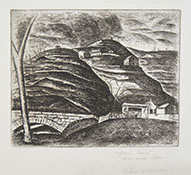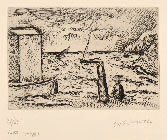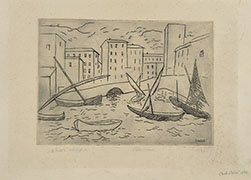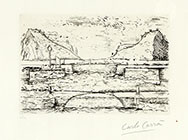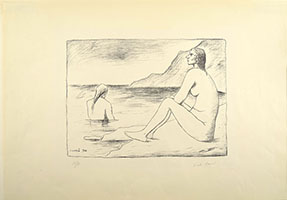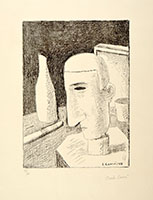(Quargnento, Alessandria 1881 - Milan 1966)
LA NASCITA DI VENERE, 1923
Etching, a fine impression, one of the very few copies printed outside the numbering in 1923 (the numbered edition was twenty-five). Signed in the plate C. CARRA’, dedicated, located and dated in pen at bottom right Agli amici Ada e Eugenio Chiostri / a ricordo del soggiorno di Massimo / Carlo Carrà / Milano 19 ottobre 938.
The dedicatee is the painter Eugenio Chiostri.
PROVENANCE: Eugenio Chiostri (1885-1973)
See M. Carrà, Carlo Carrà. Opera Grafica, Venice, 1976; cat. no. 10.
A later edition of ten exists, printed in 1951 but not for sale. As usual with Carrà’s etchings a posthumous edition of sixty was printed in 1971.
As Massimo Carrà remarked, this print and a drawing connected (1920) is the source of Carrà’s painting Venere Anadyomene (1944)
Carrà was born to a family of artisans. After working as a mural decorator for about ten years in the cities of Valenza Po, Milan, Paris, London and Bellinzona, in 1906 he enrolled at the Brera Art Academy. In 1908 Carrà became friend with Boccioni and Russolo. The three artists met Marinetti in 1910, and together published the Manifesto dei pittori futuristi. Carrà's Futurist phase ended around the time World War I began. His work, while still using some Futurist concepts, began to deal more clearly with form and stillness, rather than motion and feeling. Carrà soon began creating still lifes in a style he, along with Giorgio de Chirico, called metaphysical painting. In 1933 Carrà was a signatory with Sironi, Campigli and Achille Funi to the Manifesto della pittura murale. He became Professor of Painting at the Brera Art Academy in 1941. Carrà took up etching in 1922 and in the same year he made his first lithograph for the Bauhaus portfolio of prints by Italian and Russian artists. He made forty-five etchings in the years from 1922 to 1924 and a further five lithographs and an aquatint in 1927 and 1928. He returned to printmaking only in 1944, when twenty-two lithographs were published in the portfolio Segreti.

